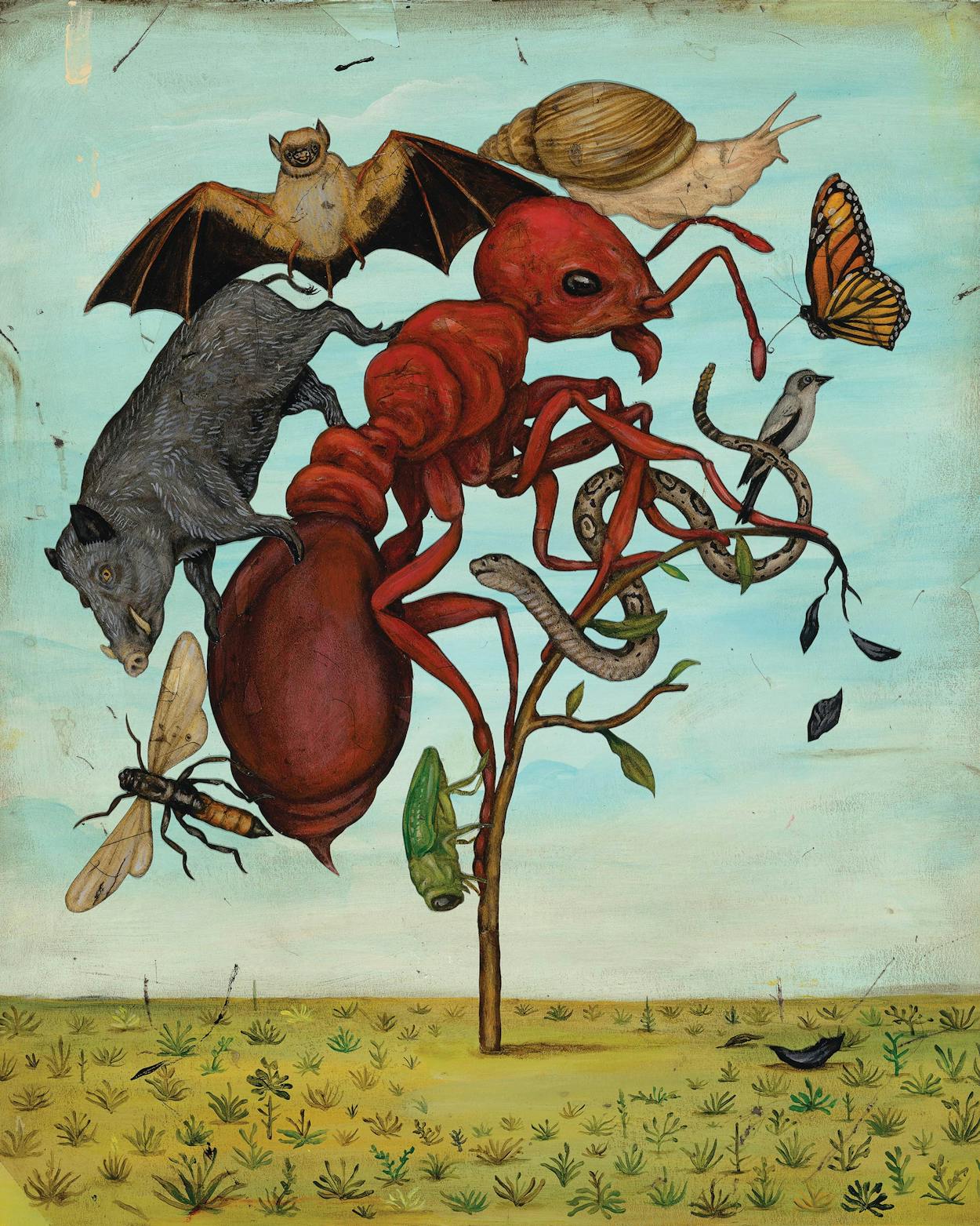When Solenopsis invicta, a.k.a. the red imported fire ant, was first identified in East Texas, in the seventies, stakes were high. Since hitching a ride from Brazil to Alabama in a ship’s ballast a few decades earlier, the insects had resisted all efforts to slow their long march west. Experts predicted that they would wreak untold havoc on Texas’s ecosystem.
In response, counties set up quarantine areas that quickly doubled, then tripled, in size. The Texas Department of Agriculture doused more than half a million acres with a chemical called MV-678 that was supposed to render the next generation of fire ants sterile and lazy. (It did not.) Landowners drenched fire ants in diesel oil, convinced that this was an effective method for doing away with them. (It wasn’t.) The August 1988 cover of Texas Monthly declared the fire ant “Public Enemy #1.”
“People were geeked out about this,” said Robert Puckett, an entomologist at Texas A&M University who studies fire ants. “It was the first time we had an invasive ant species sweeping the state.” But it was hardly the only invasion of an unwanted visitor.
In the decades since the fire ant’s arrival, millions of feral hogs have stampeded across Texas, tearing up farmland and spreading disease. Zebra mussels have clogged our lakes and rivers. A beautiful green beetle, the emerald ash borer, has spent the past six or so years settling down in North Texas, where it will likely devastate the ash tree population. In the Gulf, the recent population explosion of the voracious lionfish has serious ramifications for our coral reefs. Spotted lanternflies, apple snails, sirex wood wasps, spongy moths, brown marmorated stink bugs, giant African snails—the list of unwelcome arrivals goes on and on.
And yet these radical alterations to the biosphere have made little impression on Texans. For most of us, fire ants have always been here, and they seem as Texan as rattlesnakes or bobcats, just another specimen of the state’s notoriously savage fauna, red in tooth and claw and mandible. “The fire ants themselves haven’t changed that much,” Puckett said of the insects’ tenure in Texas. “But our response to them has evolved. They’ve just become part of our reality.”
While many of us can get away with ignoring all these changes to our surroundings, other animals don’t have the luxury of indifference. Thanks largely to habitat loss, pesticide use, climate change, and competition with invasive species, native creatures are suffering. The populations of many birds, including the eastern meadowlark and the loggerhead shrike, have declined by at least 65 percent since the sixties. The numbers of Attwater’s prairie chickens, black-footed ferrets, and monarch butterflies—all native species—have fallen precipitously. The Texas horned lizard, the once ubiquitous state reptile, is now bred in captivity; apparently shooting blood out of your eyes isn’t the evolutionary advantage it once was. Texas has about 76,000 native species. Nearly 1,300 of them are facing decline or worse.
The landscape these animals reside in is shifting as well. Texas has lost 90 percent of its blackland and coastal prairies. The great, waving plains of big bluestem and eastern gamagrass that once defined vast stretches of the state are now covered with agriculture, residential and commercial development, or St. Augustine grass. Giant salvinia, an aquatic fern that’s native to southern Brazil, has nearly choked Caddo Lake. Glossy privet are replacing native oaks and yaupon holly.
None of this is inevitable; we could choose, collectively, to restore much of the Texas that once was rather than mourn it. And many are trying to do just that. When Flower Mound resident Kathryn Wells moved to Texas twelve years ago, she fell for the beauty of the native landscape. A member of the Native Plant Society of Texas and a Texas master naturalist, she’s built her small plot of land into a certified wildlife habitat and a monarch way station, gradually adding native species from ground cover to overstory. “I think the pendulum is swinging back in the direction of regenerating the land and honoring the land,” Wells said. “The more I learned, the more I wanted to protect and steward my little corner of the world.”
Yet even as a few green-minded folks are wresting control back from invaders, the mighty fire ant may have its own to contend with. Twenty years ago, another ant from Brazil made its way to Texas—Nylanderia fulva, or the tawny crazy ant. It too is spreading rapidly across the state, and though it doesn’t sting, it swarms with such intensity that it can destroy electrical equipment and kill birds, lizards, scorpions, and snakes. What’s more, it secretes a formic acid that makes it invulnerable to the fire ant’s sting. “Crazy ants beat fire ants,” the Texas Scientist magazine declared a few years back; the newcomers have already begun displacing fire ants along the Gulf Coast.
Just as we did in the eighties, Texans have turned to science in an effort to exterminate a species of hostile invaders. Homeowners have made use of increasingly complex pesticide treatments to combat the crazy ants’ spread. University of Texas researchers are investigating a naturally occurring fungus that could destroy their colonies.
This would, of course, redound to the benefit of the fire ant, which is unaffected by the fungus. But maybe that’s okay. Perhaps Texans would rather stick with the devil they know.
This article originally appeared in the February 2023 issue of Texas Monthly with the headline “Six Legs Over Texas.” Subscribe today.
- More About:
- Critters







